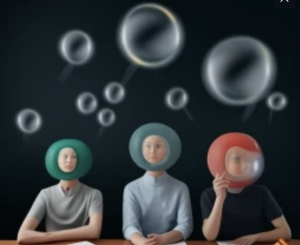Human beings harbor a deep need to belong. The well-known psychologist Abraham Maslow established a hierarchy of human needs in which he placed the need to belong just above food, water, and physical safety.
At the most basic level, belonging is survival and safety: if we’re not part of the herd, we’ll be left behind and unprotected, which means we’ll die. But these days, belonging is less about physical survival and more about surviving emotionally. We need to belong to something larger than ourselves in order to feel safe, valued, connected, and ultimately, well.
Community is something we belong in and to. It can feel particularly important to be part of a community during the holidays when we come together with our “people” to celebrate rituals and express gratitude for one another. For many people, there’s a greater longing and also an added pressure to belong to a community during this season.
Being part of a community is sometimes viewed as evidence of a good life; to some degree, it is an important factor in a good life and overall contentment. Interestingly, the word “community,” when broken down, has “common” as its root and “unity” as its suffix. And indeed, community is a place where we share and benefit from a common unity with others.
In recent times, however, our community experience has changed profoundly due to our world becoming an online world. In part because of COVID, but also because our world happens on screens now—in a virtual universe. Social media has become our new shared space, the place where we socialize and create community. We don’t gather in person, face to face, as we used to. And furthermore, we don’t seem to think it’s necessary. And yet it is–so necessary.
At one time, the makers of technology may have intended for it to bring people together and create community and a richer experience of life. Regardless of the original intention, however, the system (strengthened by the pandemic) has turned on itself. Recent studies have found that despite being more connected than ever, people feel more alone and less a part of community than ever.
In my book, The Power of Off, I wrote:
“Sadly, with technology we risk winning the world but losing our village. We can be part of a community made up of people all over the world but not talk to the few people who share a bus stop with us every morning. Though known about by everyone, we are increasingly known by no one.”
According to research conducted at the Center for Cognitive & Social Neuroscience at the University of Chicago, the more face-to-face interactions we have, the less lonely we are, while the more online interactions we have (the sort that doesn’t lead to face-to-face contact), the more lonely we are.
When the waitress at the local diner asks us if we want our ‘usual’ or the coffee cart barista notices that we weren’t there the morning before, such experiences make us feel seen, connected, and, ultimately, content. Our need to belong, to feel part of something larger, is met at a primal level when we are part of a physical, real-life community.
Being together and sharing space with other people becomes part of our cellular makeup in a way that’s different, emotionally and neurologically, from sharing something at a distance through the computer. Our body absorbs and retains in-person experiences on a deeper and more integrated level than online experiences. A hug, holding another’s hand, physical touch, all of these kick-off endorphins in our brain, which make us feel good, and which the online community doesn’t offer. Bodies respond to other bodies. The heart responds to direct human contact.
In-person community is also good for us in unexpected ways. For one, it makes us more flexible as human beings and also more empathic. In the physical world, we have to work with and consider others in a way that online relating does not require. Now that it’s possible again, we have to change out of our pajamas, leave our homes, and interact with the world.
Real-life community forces us to get out of the bubble of not just our living room but also our own minds and the narratives we tell ourselves. It demands that we work with others and not just bunker down in our private universes, convinced of our own ideas and thoughts.
Equally important, the physical community offers the opportunity to stretch emotionally and sometimes even to do something hard. Joining a group online or gathering with people over Zoom, for the most part, asks very little of us. Often we can leave when we want to; we can give half our attention and tinker with other projects while it’s happening. In some sense, the online community allows us to be the laziest and least evolved versions of ourselves, physically and attentionally.
Real-life community, on the other hand, challenges us to raise our game and do hard things; it not only demands the effort of leaving the house and showing up physically, but it asks that we show up attentionally present as well, actually there, which is not the easiest and most convenient path to which we’ve grown accustomed.
But the case for all this is in the “boots on the ground” reports. Most people describe a sense of contentment and security when they experience themselves as being part of a shared physical world and physical, real-life community. These same people report feeling empty, unsatisfied, and lonely after hours of participating in virtual communities, precisely the opposite of the experience they crave, and that face-to-face community creates.
I’m not suggesting that we throw away our virtual communities; they serve an important purpose in our lives. And yet, we need to honor the nourishment that comes from spending time in physical community—out in the actual world. In order to reap this nourishment and contentment, however, we need to consciously make time to be together, face to face. Only we can make this happen for ourselves.
So, with a new year on the horizon, and the limitations of the pandemic easing, why not make this the moment to reenter life in an intentional, self-caring, and wholehearted way? Why not give yourself the gift of real-life community, now that you can—the fulfillment of being with other people in union?
You can start with baby steps; take a walk with a friend rather than spending an hour texting “together;” join a class or group that meets in person; go to your local bookstore or community center for an event, or attend a service at a spiritual center. Regardless of what ends up sticking or becoming a habit, I promise you this: real-life physical community, face-to-face, shoulder-to-shoulder, heart-to-heart interaction, in union, holds the possibility of nourishing you more than any other choice you’ll make in 2023.
See you out in the world…


